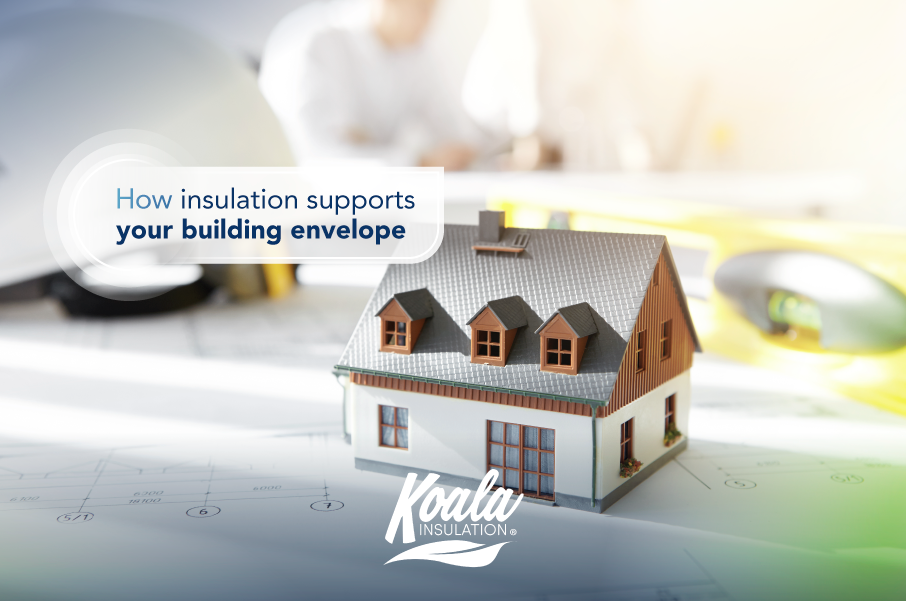
How insulation supports your building envelope

If you’ve done some research into insulation or if you’ve looked into doing some work around your home, you’ve surely come across the term “building envelope” at some point. The building envelope combines structural integrity, moisture control, temperature control and air pressure boundaries into one single engineering design that serves as a physical separator between the conditioned and unconditioned environment of your home. That physical separator usually consists of the foundation, roof, walls, doors, windows, ceiling, and their related barriers and insulation.
A building envelope serves many functions which can be divided into three main categories:
- Support: your building envelope provides support for your home against external forces.
- Control: The envelope controls the exchange of water, condensation, air and heat between the inside and outside of your home.
- Finish: Your building envelope provides the aesthetic exterior of your home.
Tight vs. loose building envelopes
Building envelopes are often categorized into “tight” or “loose”. A loose building envelope allows more natural air transfer which can take the place of mechanical ventilation. However, loose buildings are usually more drafty and uncomfortable as their temperatures are more difficult to regulate and more heat & humidity can enter. Especially in Florida, that means high energy bills due to the heat coming in and a higher chance of mold and mildew due to the humidity.
A tighter building envelope on the other hand allows for more control over your indoor air quality, temperature, humidity levels and your energy consumption, but will need more extensive mechanical ventilation. This tighter envelope is created by insulation, caulk, sealants and energy-efficient windows that keep out the heat and humidity and therefore prolong the life of the building components.
Insulation as part of your building envelope
As mentioned above, insulation is an integral part of your building envelope. You could therefore say that non- or under-insulated homes (so nearly 90% of homes in the US) are not efficiently protecting the inside of their home from the outside. In order To have a comfortable, energy-efficient home where the cooling sources are not constantly fighting the exterior elements making their way inside the house, insulation and air sealing are two key steps in creating a good thermal building envelope.
The extra layer of foam, loose-fill or batt insulation creates a thermal barrier between your air-conditioned space that, with the right R-value, will effectively keep the heat out of your attic and therefore out of your living space which means that your A/C won’t have to run as much. As a result, you will be saving money on your energy bills.
Insulation does not only act as part of the thermal building envelope but also offers other benefits:
Insulation for better indoor air quality
Insulation can act as a barrier against insects, allergens and other air pollutants that might otherwise travel from the outside into your living space and make your family sick. Especially in combination with air sealing, it can also keep the humidity low and therefore reduce the risk of mold and mildew which could lead to serious health risks as well.
Insulation for better structural integrity
Especially closed-cell spray foam insulation, as it hardens into a rigid layer, can add to the structural integrity of your home. The combination of the material’s density and rigidness helps create a stable service that adds extra reinforcement and stability to the exterior walls and stud cavities of your home. Research conducted by the National Association of Home Builders has shown that walls with closed cell spray foam have a racking strength (a measure of a building system's ability to resist wind loads) up to 300% greater than walls without it. That means that walls with closed-cell spray foam offer more protection against outside forces like hurricanes and other natural disasters.
Get thermal and structural protection for your home by giving Koala Insulation of North Broward & Boca a call today!
Ready to book your free insulation evaluation?
We have 3 convienant ways for you to get in touch
We Provide Insulation Services to the Following North Broward & Boca Areas
BOCA RATON, DELRAY BEACH, POMPANO BEACH, CORAL SPRINGS, TAMARAC, DEERFIELD BEACH
Counties Served
PALM BEACH, BROWARD
Zip Code
33431, 33432, 33433, 33444, 33445, 33483, 33486, 33487, 33076, 33428, 33434, 33446, 33484, 33496, 33498, 33063, 33065, 33071, 33321, 33064, 33067, 33073, 33441, 33442
